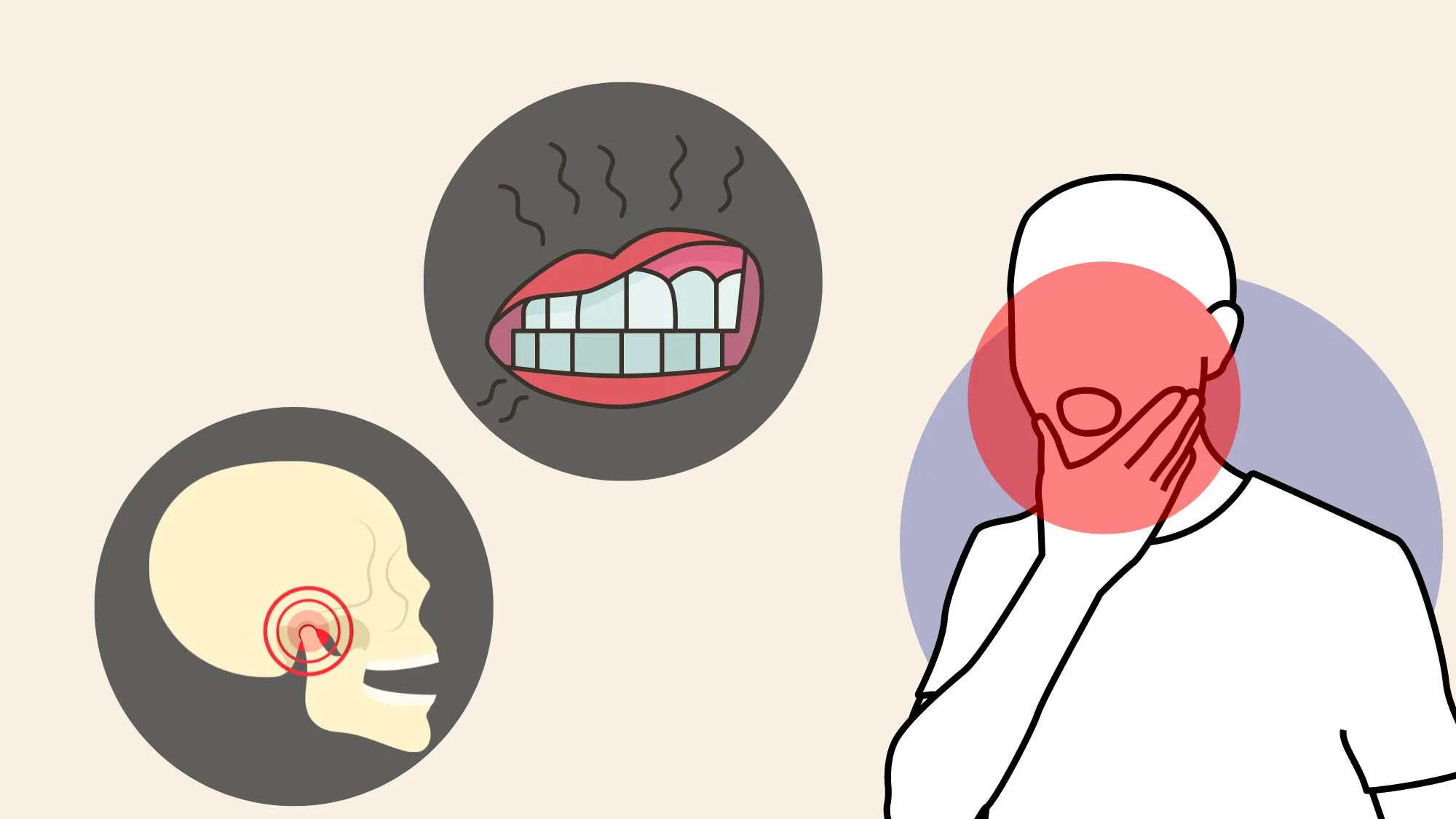
TMJ is short for temporomandibular joint, the joint that links the jawbone to the skull, and TMJ disorders (TMD) encompass a wide range of conditions that impact the temporomandibular joint, as well as the muscles and tissues surrounding it; symptoms of TMJ disorder also vary. Although people commonly use the term “TMJ” to describe these conditions, it technically refers to the jaw joint itself, which is why the more accurate term for the disorders is TMD or temporomandibular joint dysfunction. TMD affects a significant portion of the adult population.1
Each person has two temporomandibular joints, located on either side of the face, just in front of the ears. These joints connect the lower jawbone (mandible) to the skull and play a crucial role in essential movements like chewing and speaking. Furthermore, TMD is typically marked by jaw joint pain, muscle spasms or discomfort, and impaired function in the muscles responsible for jaw movement. That being said, it can present in a variety of different ways for different people.1
Symptoms of TMJ disorder
The symptoms of TMJ disorder can vary in presentation for different individuals. However, they commonly include2:
- TMJ pain or jaw pain/tenderness. Individuals may experience discomfort or tenderness in the jaw, which can occur on one or both sides. This pain may intensify with jaw movement or while chewing. It is often recommended to avoid chewing gum or eating chewy foods that can stress the joint.
- Difficulty or discomfort while chewing. There may be challenges in fully opening or closing the mouth due to discomfort. Additionally, some individuals may notice a clicking, popping, or grating sound when moving their jaw while chewing or speaking.
- Facial muscles pain or soreness. TMJ disorder can lead to facial pain or soreness, especially around the jaw joint, jaw muscles, temples, or in front of the ears. This pain can be persistent or occur intermittently.
- Headaches: Frequent headaches, including tension headaches or migraines, can be associated with TMJ disorders. These headaches may be localized in the temples, forehead, or the back of the head, and can be a dull aching pain.
- Earaches or ringing in the ears. Some individuals with TMJ disorder can experience ear-related symptoms, including ear pain, a sensation of fullness or pressure in the ears, or ringing in the ears (tinnitus).
- Jaw locking. In severe cases, the jaw can temporarily lock in an open or closed position, making it difficult to move the jaw freely. This locking sensation can be uncomfortable and can require manual manipulation to release the jaw from its locked state.
It is important to remember that these TMJ symptoms can vary among individuals with TMJ disorder. Moreover, if you experience any of these symptoms, it is advisable to seek medical evaluation for an accurate diagnosis and seek treatment.
Causes of TMD
The exact origins of TMJ disorder can be challenging to pinpoint as it often arises from a combination of factors. Some common causes and contributing factors include:
- Jaw injury. TMJ disorder can be triggered by traumatic injuries to the jaw joint, like from car accidents or sports-related impacts. These injuries can get in the way of the proper functioning of the temporomandibular joint and lead to the development of TMJ disorder.3
- Teeth grinding or jaw clenching. Habitual grinding or clenching of the teeth, which is known as bruxism, can cause excessive pressure on the jaw joint and the surrounding muscles. Bruxism often occurs unconsciously during sleep, frequently referred to as sleep bruxism, and can strain the temporomandibular joint. This can also occur in patients with sleep apnea.4
- Arthritis. Different forms of arthritis, including osteoarthritis and rheumatoid arthritis, can affect the temporomandibular joint and contribute to the development of TMJ disorder. Arthritic conditions can cause inflammation, joint degeneration, and structural changes, resulting in TMJ symptoms.5
More potential causes of TMD
- Stress and tension. Emotional or psychological stress can manifest physically in the form of increased muscle tension throughout the body, including the jaw muscles. Persistent stress and tension can lead to jaw clenching and exacerbate TMJ symptoms. The heightened muscle activity can strain the jaw joint and contribute to the onset or aggravation of TMJ disorder.6
- Poor posture. Maintaining poor posture, particularly for neck muscles and muscles in the upper back regions, can impose excessive strain on the jaw joint. Slouching or misaligned spine can disrupt the natural alignment of the temporomandibular joint, leading to TMJ disorder over time.7
- Dental problems. Issues related to dental alignment and occlusion can influence the development of TMJ disorder. Malocclusion, which describes misalignment of the teeth, an improper bite relationship, or missing teeth, can disrupt the harmonious function of the jaw joint. The irregularities in dental structures can contribute to the misalignment of the temporomandibular joint and contribute to TMJ disorder.8
- Chronic pain. TMD can be associated with chronic pain, defined as pain that lasts for an extended period of time, typically more than three months. TMD-related chronic pain can significantly impact a person’s quality of life and daily functioning. The exact cause of TMD-related chronic pain is not fully understood, as TMD itself can have multiple contributing factors.9
TMD and blood flow
The exact relationship between TMD and blood flow is not fully understood and varies depending on individual circumstances. Pain and muscle tension associated with TMD can potentially affect blood flow in the surrounding tissues. When muscles are tight or inflamed, they may constrict blood vessels in the area, leading to reduced blood flow. Moreover, decreased blood flow can result in oxygen and nutrient deprivation to the affected tissues, potentially exacerbating pain and impairing the healing process. Insufficient blood flow can get in the way of delivering necessary nutrients and oxygen to the tissues, slowing down the healing process and potentially prolonging the recovery from TMD.10
It’s important to note that TMD is a complex condition influenced by various factors, including muscle tension, joint alignment, inflammation, and psychological factors like stress.
TMJ flare-ups
TMJ flare-ups refer to episodes or periods of increased symptoms and discomfort associated with TMD. These flare-ups can vary in intensity and duration and are characterized by a worsening of the existing TMD symptoms.11
Common symptoms of flare-ups
During a TMJ flare-up, you might experience increased jaw pain, which can range from mild to severe. The pain may be localized to the jaw joint or radiate to the surrounding areas, such as the temples, ears, or neck. Flare-ups can also cause difficulty in opening and closing the mouth, leading to limited jaw movement or jaw locking.11
Other common symptoms during a TMJ flare-up include headaches, facial pain, earaches, clicking or popping sounds in the jaw joint, and muscle pain or stiffness or tenderness around the jaw and face. Some individuals may also experience changes in their bite or tooth sensitivity during flare-ups.11
Triggers of flare-ups
Flare-ups can be triggered by many different things, such as stress, grinding teeth or clenching (bruxism), jaw injury, poor posture, excessive chewing, or certain habits like nail-biting or gum chewing. Additionally, underlying conditions like arthritis, joint misalignment, or muscle tension can contribute to the frequency and severity of flare-ups.11
Management of flare-ups
Management of TMJ flare-ups typically involves a combination of self-care measures and professional interventions. This can include applying heat or cold compresses to the affected area, practicing relaxation techniques to reduce stress, avoiding hard or chewy foods, practicing jaw exercises to improve muscle function and flexibility, using over-the-counter pain relievers. In some cases, seeking treatment from a dentist or a healthcare professional specializing in TMD can be helpful.
It is important for to consult with a healthcare provider or dentist for an accurate diagnosis and appropriate treatment plan tailored to their specific needs when experiencing a flare-up.11
Diagnosis of TMD
The diagnosis of TMJ disorder is usually done by experienced healthcare professionals, dentists, or specialists in TMJ disorders through the conduction of a thorough assessment.12
It begins with an in-depth review of the patient’s medical history, where healthcare providers inquire about any previous jaw injuries, dental treatments, or other relevant health conditions. Moreover, a detailed discussion about symptoms, such as jaw pain, difficulty in chewing, or clicking sounds, helps to provide valuable information for potential diagnosis.
A physical examination is a crucial component of diagnosing TMJ disorder. This is when the healthcare professional carefully examines the jaw joint and its surrounding areas to detect any tenderness, swelling, or abnormalities. The range of motion of the jaw is evaluated by assessing your ability to open and close your mouth, move your jaw from side to side, and perform other jaw movements. Any abnormal sounds, such as clicking, popping, or grating, that occur during these movements are carefully noted.
Additional tests
To obtain a more detailed view of the temporomandibular joint and rule out other potential causes, imaging tests may be ordered. X-rays can provide valuable insights into the bony structures and reveal any abnormalities or signs of degeneration in the joint. In some cases, more advanced imaging techniques such as CT scans or MRI scans may be used to obtain high-resolution images of the joint and surrounding soft tissues.
Additionally, on top of the physical examination and imaging tests, dental evaluations are often conducted to assess the alignment of the teeth and the bite relationship. This evaluation helps identify any dental-related issues, such as malocclusion or missing teeth, that may contribute to TMJ symptoms.
By combining the information gathered from history, physical examination, imaging tests, and dental evaluations, healthcare professionals can reach an accurate diagnosis of TMJ disorder. This diagnosis serves as the foundation for developing a personalized treatment plan tailored to address your specific needs, severity of symptoms, and underlying causes of their TMJ disorder.
Treatment of TMD
The treatment of TMJ disorder usually requires a comprehensive approach that targets both the symptoms and the root causes of the condition. This approach often involves a combination of various therapies and interventions to provide effective relief. Here are some treatment options commonly utilized for TMJ disorder13:
- Self-Care Practices: Adopting self-care practices can help alleviate pain and symptoms and promote healing. This can include resting the jaw by avoiding excessive chewing of hard or tough foods, including chewing gum, practicing relaxation techniques to reduce muscle tension, and implementing stress management strategies.
- Physical Therapy: Physical therapy plays a crucial role in TMJ disorder treatment. A physical therapist can guide patients through exercises and stretches that improve jaw mobility, strengthen the muscles around the joint, and promote proper alignment. They may also incorporate techniques such as ultrasound therapy, heat or cold therapy, and manual manipulation to reduce pain and inflammation.
- Pain Management: Over-the-counter drugs to relieve pain, such as nonsteroidal anti-inflammatory drugs (NSAIDs), can be used to manage pain and reduce inflammation associated with TMJ disorder. In more severe cases, a healthcare professional may prescribe stronger pain medications or muscle relaxants to provide relief.

symptoms of TMJ disorder
Your medications, including any over-the-counter pain relievers, can be accurately tracked on the CareClinic App!
More treatments for TMD
- Stress Reduction Techniques: Since stress can exacerbate TMJ symptoms, stress reduction techniques play an important role in treatment. This includes exploring relaxation techniques such as deep breathing exercises, meditation, yoga, or engaging in activities that promote relaxation and overall well-being.
- Dental Treatments: For individuals whose TMJ disorder is related to dental issues, dental treatments may be recommended. These can include the use of oral appliances, such as splints or mouthguards, to provide support and alleviate pressure on the jaw joint. In cases of malocclusion or improper bite alignment, orthodontic treatments or dental restorations may be necessary to correct the underlying dental problems contributing to TMJ disorder.
- Surgical Interventions: In severe and persistent cases of TMJ disorder, surgical interventions might be considered. These procedures are typically reserved for situations where conservative treatments have not provided sufficient relief. Surgical options can involve joint repair or replacement, arthrocentesis (fluid removal), or arthroscopy (minimally invasive joint examination and treatment).
It is crucial to consult with a healthcare professional or dentist experienced in TMJ disorders for an accurate diagnosis and personalized treatment plan tailored to your specific needs. They will assess the severity of your condition, consider underlying causes, and recommend the most appropriate combination of treatments to alleviate your TMJ symptoms and improve your overall jaw function.
The American Dental Association (ADA) acknowledges the existence and significance of TMJ disorders. They recognize that TMJ disorders can cause discomfort and affect a person’s ability to perform regular activities, such as eating and speaking. The ADA encourages dental professionals to be knowledgeable about TMJ disorders, understand the signs and symptoms, and be prepared to provide appropriate care or refer patients to specialists if necessary.14
A word on stress reduction
Stress reduction is crucial for individuals with TMD as stress can worsen symptoms of TMJ disorder and contribute to muscle tension and jaw clenching. By incorporating stress reduction techniques into daily life, those with TMD can help manage the condition and improve overall well-being. Here are some effective stress reduction strategies specifically tailored for TMD15:
- Relaxation techniques: Practicing relaxation techniques can help reduce stress and alleviate TMD symptoms. Deep breathing exercises, progressive muscle relaxation, guided imagery, and meditation are examples of relaxation techniques that promote relaxation, reduce muscle tension, and promote a sense of calm.
- Stress management: Identifying and managing stressors in your life can significantly impact TMD symptoms. Make an effort to identify stress triggers and find healthy ways to cope with them. This may involve prioritizing self-care, setting boundaries, delegating tasks, and engaging in activities that promote relaxation and enjoyment.
- Physical activity: Engaging in regular physical activity has been shown to reduce stress and improve overall well-being. Choose activities that you enjoy and are low-impact to avoid putting excessive strain on your jaw. Walking, swimming, yoga, and tai chi are excellent options that promote relaxation and enhance flexibility.
- Jaw relaxation exercises: Incorporating jaw relaxation exercises into your daily routine can help relieve muscle tension and reduce TMD symptoms. Gentle jaw stretches, tongue-to-roof-of-mouth exercises, and jaw massages can promote relaxation and increase jaw mobility. Consult with a healthcare professional or physical therapist for guidance on specific exercises tailored to your needs.
More stress reduction techniques
- Heat and cold therapy: Applying heat or cold packs to the jaw area can help alleviate pain and reduce muscle tension. Experiment with both heat and cold to determine which provides you with the most relief. Use caution not to apply extreme temperatures directly to the skin and limit application time to avoid potential tissue damage.
- Proper posture: Maintaining good posture can minimize strain on the jaw and neck muscles, reducing TMD symptoms. Be mindful of your posture throughout the day, especially during activities that may contribute to jaw tension, such as using electronic devices or sitting at a desk. Sit upright, keep your shoulders relaxed, and avoid excessive forward head posture.
- Mind-body practices: Mind-body practices such as yoga, tai chi, and qigong combine gentle movement, deep breathing, and mindfulness, promoting relaxation and reducing stress. These practices can help improve body awareness, release muscle tension, and cultivate a sense of calm.
- Seek support: Don’t hesitate to seek support from healthcare professionals, support groups, or therapists specializing in TMD or stress management. They can provide guidance, education, and emotional support, helping you navigate your TMD journey and develop effective stress reduction strategies.
Remember that stress reduction techniques are not one-size-fits-all, so it’s important to explore and find what works best for you. Implementing these strategies consistently and integrating them into your daily routine can have a positive impact on your TMD symptoms, promoting overall well-being and quality of life.

symptoms of TMJ disorder
The CareClinic App is a great way to track your progress on pain management, including logging your stress reduction techniques and mindfulness strategies!
References
- Cleveland Clinic. “How to Treat TMJ Pain.” Cleveland Clinic, my.clevelandclinic.org/health/diseases/15066-temporomandibular-disorders-tmd-overview#:~:text=TMJ%20dysfunction%20(TMD)%20causes%20pain.
- Mayo Clinic. “TMJ Disorders – Symptoms and Causes.” Mayo Clinic, 2018, mayoclinic.org/diseases-conditions/tmj/symptoms-causes/syc-20350941.
- Ingawale, S., & Goswami, T. (2009). Temporomandibular joint: disorders, treatments, and biomechanics. Annals of biomedical engineering, 37, 976-996.
- Reddy, S. V., Kumar, M. P., Sravanthi, D., Mohsin, A. H. B., & Anuhya, V. (2014). Bruxism: a literature review. Journal of international oral health: JIOH, 6(6), 105.
- Savtekin, G., & Şehirli, A. Ö. (2018). Rheumatoid arthritis in temporo-mandibular joint: a review. Nigerian Journal of Clinical Practice, 21(10), 1243-1246.
- Weinberg, L. A. (1977). An evaluation of stress in temporomandibular joint dysfunction-pain syndrome. The Journal of prosthetic dentistry, 38(2), 192-207.
- Salkar, R. G., Radke, U. M., Deshmukh, S. P., & Radke, P. M. (2015). Relationship between temporomandibular joint disorders and body posture. Int J Dent Health Sci, 2(6), 1523-30.
- Inui, M., Fushima, K., & Sato, S. (1999). Facial asymmetry in temporomandibular joint disorders. Journal of oral rehabilitation, 26(5), 402-406.
- Buescher, J. J. (2007). Temporomandibular joint disorders. American family physician, 76(10), 1477-1482.
- Makihara, E., & Masumi, S. I. (2008). Blood flow changes of a superficial temporal artery before and after low-level laser irradiation applied to the temporomandibular joint area. Nihon Hotetsu Shika Gakkai Zasshi, 52(2), 167-170.
- Group, Ceatus Media. “How Long Do TMJ Flare-Ups Last? | the Headache & TMJ Center of New Jersey.” Headache & TMJ Center of New Jersey, 18 May 2021, www.headachetmjnewjersey.com/how-long-do-tmj-flare-ups-last/.
- “TMJ Disorders – Diagnosis and Treatment – Mayo Clinic.” org, 2018, www.mayoclinic.org/diseases-conditions/tmj/diagnosis-treatment/drc-20350945.
- Fries, Wendy C. “Temporomandibular Joint Disorders (TMD, TMJ).” WebMD, WebMD, 3 June 2003, webmd.com/oral-health/guide/temporomandibular-disorders-tmd.
- “Temporomandibular Joints (TMJ).”Mouthhealthy.org, 2023, www.mouthhealthy.org/en/all-topics-a-z/tmj.
- Hill, Dr Chris. “Improve Your TMJ Symptoms by Reducing Stress with 7 Easy Ways.” Smile on Dental Studio, 12 Jan. 2021, www.smileonstl.com/blog/reduce-stress-tmj/.


